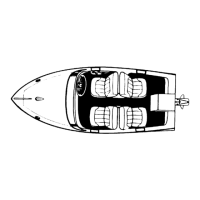90-823225--1 10965E-104 - ELECTRONIC FUEL INJECTION (MULTI-PORT AND THROTTLE BODY)
Code 23: Intake Air Temperature (IAT) Sensor Circuit (Scan)
(1 of 2)
AB
INTAKE
IAT SENSOR SIGNAL
REFERENCE
CIRCUIT DESCRIPTION:
The Intake Air Temperature (IAT) sensor uses a
thermistor to control the signal voltage to the Elec-
tronic Control Module (ECM). The ECM applies a
voltage (about 5 volts) on CKT 472 to the sensor.
When the air is cold, the sensor (thermistor) resis-
tance is high; therefore, the ECM will see a high sig-
nal voltage. If the air is warm, the sensor resistance
is low; therefore, the ECM will see a low voltage.
TEST DESCRIPTION:
Number(s) below refer to circled number(s) on the
diagnostic chart.
1. A Code 23 will set, due to an open sensor, wire
or connection. This test will determine if the wir-
ing and ECM are OK. If the scan tool indicates a
temperature of over 266°F (130°C), the jumper
harness to the sensor should be checked before
replacing the sensor.
2. This will determine if the IAT sensor signal (CKT
472) or the IAT sensor ground (CKT 813) is open.
3. This step will determine if the fault is in the IAT
sensor or the circuit.
DIAGNOSTIC AIDS:
The scan tool reads temperature of the air entering
the engine and should read close to ambient air tem-
perature when engine is cold, and rises as engine
compartment temperature increases.
The IAT sensor in this engine is located on the star-
board underside of the plenum.
Carefully check harness and connections for pos-
sible open.
If the engine has been allowed to sit overnight, the in-
take air temperature and coolant temperature values
should read within a few degrees of each other.
An intermittent problem may be caused by a poor or
corroded connection, rubbed through wire connec-
tion, a wire that is broken inside the insulation, or a
corroded wire.
Any circuitry that is suspected as causing the inter-
mittent complaint should be thoroughly checked for
backed-out terminals, improper mating, broken
locks, improperly formed or damaged terminals, poor
terminal-to-wiring connections, corroded terminals
and/or wiring, or physical damage to the wiring har-
ness. After repairs, clear codes following “Clearing
Codes” in “ECM Self-Diagnostics.” Failure to do so
may result in codes not properly being cleared.

